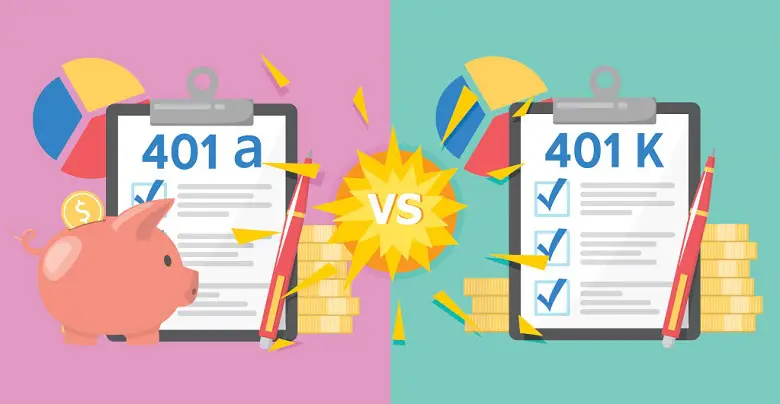Finance News
401a vs 401k: What’s the Difference

- 401a is a retirement plan that is generally offered by non-profit employers or public employers, while 401k is a retirement plan which is more common in the private sector.
- The employer determines contribution limits in 401(a), on the contrary in 401(k) employee dictates how much they wish to contribute to their plan.
- The 401(k) plan is a retirement savings plan offered by employers in the private sector; employees can save a part of their paycheck monthly and deposit the amount.
- The 401(a) plan is offered by non-profit organizations, tax-exempt organizations, and government agencies.
Even though 401a and 401(k) have similar goals, there are differences in contribution limits and investment options. This article will discuss the differences between the two, their investment options, non-profits percentage, incentive, and taxable income.
About the 401(a) plan
- The 401(a) plan is a retirement plan that permits a certain contribution, within limits, from employee and employer. The employer, who will sponsor the retirement plan, decides employee contributions and investment choices available to participants.
- The employee can proceed to withdraw their personal finances from the plan a 401 and work on their pension plan in different ways: receiving employer sponsored retirement annuities as a part of their retirement savings plans, investing in a tax-free lump-sum payment account, or move a portion of wages into another qualified retirement savings plan (listen to your advisor).
- Nonprofit and government organizations like schools, universities, government educational institutions, and non-profit education institutions offer the 401(a) scheme.
- Investments made in the 401(a) helps avoid risky investing and includes funds obtained from value-based stocks and government bonds; the employer may acquire a greater share of control over the investment options.
About the 401(k) plan
- The 401(k) plans refer to a defined-contribution, company-sponsored, and tax-advantaged type of retirement account that is offered by employers to employees.
- The savings plan has been named according to the Internal Revenue Code of the US.
- The employees make contributions to the 401(k) plan accounts through their automatic payroll in a way so that employers, as payroll providers, can match a certain percentage of the dollar amount.
- The employers also make matching employer contributions according to the provisions of the traditional 401 (k) plans.
- There is no pre tax imposed on the investment earnings obtained from the 401(k) plans according to the income tax code. However, one should keep in mind the financial data that the non-taxability condition is only valid until the money gets withdrawn by the employee after retirement.
- There is no provision for tax benefits/a tax benefit. Users must be aware of the distinction and pick an option wisely.
- On the basis of banking advice given by experts, for avoiding taxes on returns, most employers and employees opt for the 401(k) that is given access by the retirement program of the corporations to certain employees who seek the maximum amount without the deduction of any amount to the tune of thousands of dollars in the form of taxes.
- That is why in comparison to the traditional 401(k) contribution plan, the Roth 401(k) option is better because of the tax advantages upon withdrawals (there is no tax deduction).
- Most businesses offer both types of accounts for the purposes that the workers can make withdrawals without worrying about the distribution formula of tax incentives, fees, and deductions, all rights reserved by the corporation.
Difference between 401a vs 401k Retirement Plan
- Knowing the key differences between 401 (a) vs. 401(k)can help you make a choice of deferrals in the future between the schemes. The contrast between 401(k) and 401 (a) plans are tabulated below:
| Parameters | 401(a) plans | 401(k) plans |
|
|
|
|
|
|
|
|
|
|
|
|
|
|
|
|
|
|
FAQs
Is a 401a better than a 401(k)?
- 401k provides tax advantages over the funds while 401a does not.
- The 401k order can be considered to be a more suitable elective plan for savings after retirement.
- However, it is not for the employee to choose between the plans as it is the employer’s employment disclosure articles and sources that decide the scheme to be offered to the employee.
- Only non-profit and governmental staff qualify for the 401 assets scheme, whereas the staff who works on a for-profit basis qualifies for the 401(k) contribution plans.
- The difference between the plans makes the advantages of 401k, and 401(a) plans more comprehensible. One can also opt for the 403 b plan for extra advantages after perusing through 401 (a) vs. 401(k) plans.
- The 403 b is a tax-sheltered annuity plan for employees identified by the code section 501(c)(3) tax-exempt authorities. The 403 b permits individuals to contribute their salaries to their plans. The 403 b scheme is also available for certain ministers.
Can you transfer 401a to 401(k)?
- An employee can implement the necessary technology to exercise his freedom of choice of participation by rolling over a combination of both the 401a and 401 (k) categories into similar accounts or into IRAs, as per the rule of interest.
- However, if the money gets directly credited to the account prior to the selection of rollover account and only if the employer, at such an instance, exercises power to withhold 20% of the balance as federal withholding tax, is such a transfer possible within match limits.
Can you cash out a 401a?
- According to financial advisors, employees can withdraw from the 401(a) scheme after reaching retirement or after resigning.
- Employees should pay federal income tax under the 401a plan. The IRS imposes a penalty tax of 10% for unqualified and premature withdrawals.
- The individual needs to be cautious of tax penalties while clicking on the necessary link at the website for encashing the 401a scheme distributions and offers or making an early withdrawal.
Hope our advice helps you grow your retirement savings, build a retirement plan, and put your money in the right place.



